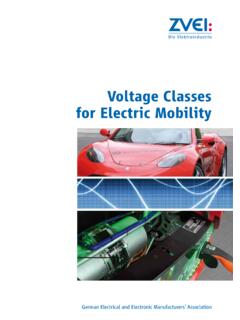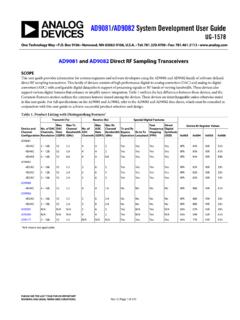Transcription of Guidelines for the Long-Term Storage of Components ...
1 Guidelines for the Long-Term Storage of Components , Subassemblies and Devices Electronic Components and Systems Division and PCB and Electronic Systems Division Guidelines for the Long-Term Storage of Components , Subassemblies and Devices Published by: ZVEI - German Electrical and Electronic Manufacturers Association Electronic Components and Systems Division and PCB and Electronic Systems Division Lyoner Stra e 9. 60528 Frankfurt am Main, Germany Phone: +49 69 6302-276. Fax: +49 69 6302-407. E-mail: Contact: Volker Kaiser March 2014. While every care has been taken to ensure the accuracy of this doc- ument, ZVEI assumes no liability for the content.
2 All rights reserved. This applies in particular to the Storage , reproduction, distribution and translation of this publication. 2. TABLE OF CONTENTS. 1. Preface 4. 2. Basic aspects 5. 3. Components under consideration 6. 4. General factors affecting Storage . and error patterns 7. Contamination 7. Corrosion 7. Diffusion 8. Moisture 8. Moisture absorption 8. Moisture extraction 8. Example of condensation in a relay 8. Embrittlement 8. Solderability: Wetting, dewetting, non-wetting 9. Popcorn effect 9. Whisker formation 10. Tin pest 10. 5. Specific factors 11. Features of active Components 11. Features of passive Components 12.
3 Special features of batteries (and accumulators) 15. Special features of printed circuit boards, assembled subassemblies and devices 18. Special features of electromechanical Components such as plastic housings and structural parts 20. 6. General recommended procedure for storing Components 22. General checklist 22. Flow diagram for Long-Term Storage 23. Explanation of individual process steps 24. 7. Minimising risks during Long-Term Storage 28. 8. Summary and outlook 28. 9. Editorial staff, members of the working group 29. 10. Sources and further reading 30. 3. 1. Preface Many functions and products would not be These Guidelines on Long-Term Storage are achievable without advances in electron- intended to help develop a supply strategy ics.
4 In particular, the wide variety of new, for Components which need to be warehoused, high-volume applications has increased the processed and used beyond the Storage period pace of innovation in the development of guaranteed by the manufacturer. It is essen- Components , subassemblies and devices. The tial to consider which factors may affect com- component industry is advancing at an expo- ponents during Storage , or adversely affect nential rate in accordance with Moore s Law, their subsequent processing or performance. which observes that the number of transistors on integrated circuits doubles approximately Ageing mechanisms and their error patterns every two years.
5 Which have a bearing on component Storage or subsequent processing are classified and Innovation cycles are getting shorter and com- described below. These Guidelines also offer ponents more powerful year on year. Memory readers recommendations for designing pro- chips, for instance, have shrunk tenfold in the cesses for Long-Term Storage , including stor- last 10 years. The consequence of this minia- age and monitoring strategies. turisation is that they become obsolete every one to two years. There is no foreseeable end Raising awareness of Storage issues during to this rate of progress beyond 2020 (source: the development of subassemblies, sub-sys- ZVEI Technologieroadmap 2020 Elektronis- tems and devices is a further consideration.)
6 Che Bauelemente und Systeme [17]). Choosing the correct materials and compo- nents during the design phase is the key to Yet at the same time there is a desire for durable successfully extending the Storage capabilities products and correspondingly robust security of Components and raw materials. The impor- of supply that will last for years. This applies tant thing is to maintain processing capability in particular to the replacement demand for and operational performance. subassemblies, systems and devices as well as for raw materials, Components and circuit These Guidelines for the Long-Term Storage of boards as required for instance by the aero- Components , subassemblies and devices' are space, automotive, railway or industrial auto- intended to supplement the ZVEI White Paper mation industries.
7 But it is not always possi- Langzeitversorgung der Automobilindustrie ble to manufacture the required products for mit elektronischen Baugruppen . prolonged periods. Action must therefore be taken to maintain supplies even when parts are no longer in series production. Conse- quently, all manufacturers of Components , subassemblies etc. must consider the availa- bility of their products right from the devel- opment phase. 4. 2. Basic aspects Long-Term Storage ' in this context means Ideally fresh goods' should be used for stor- storing Components beyond the manufac- age. If this is not possible, the previous stor- turer's guaranteed lifetime whilst retaining age conditions must be taken into account, for their functional integrity (fit, form, function).
8 Example climatic conditions. It is vital to retain component integrity so as to ensure safe subsequent processing using In addition, changes to the production and appropriate assembly and connection tech- processing of subassemblies, devices, com- nology. The manufacturer alone can assess ponents and raw materials may arise due to whether the Components under consideration environmental legislation, restrictions and are suitable for Long-Term Storage , or whether legislative changes to framework conditions. they will suffer from loss of functionality, For instance, the effects of Storage -related and should be contacted in any event.
9 If the ageing may occur considerably earlier if lead- planned Storage period is shorter than the based surface coatings are replaced with mod- shelf life guaranteed by the manufacturer, no ified coating systems. further action is required. In this case it is important to ensure that pro- The choice of Storage method depends largely cessing conditions relating to specific compo- on the intended Storage period. Beyond the nents, such as thermal profiles for soldering/. manufacturer's recommended shelf life, spe- housing and pretreatments, are archived and cial Storage conditions and processes must be can be readjusted.
10 This avoids having to rede- created which significantly slow down ageing fine production conditions. These processes processes whilst retaining processing capabil- must be established throughout the entire ity and performance. No further measures can supply chain. In the event of production relo- be taken to extend the maximum shelf life of cation, Storage and process parameters must certain Components ( batteries). Basically, be adopted without change and requalified if it is important to prevent harmful media from necessary. reaching sensitive areas in the first place. If Components are to be stored for an extended It is advisable to carry out a risk assessment period, the manufacturer must be contacted with regard to performance and processing beforehand so that, if necessary, a joint capability in order to assess all constraints approach can be agreed.







